Envision Math Grade 8 Volume 1 Chapter 6 Congruence And Similarity
Page 333 Exercise 1 Answer
Given: AB = 2, AC = 2, AD = 5 and AE = 5
To determine the similarity and difference between two triangles.
First, use the Pythagoras theorem, to find the longest side and find the ratio of the triangle.
The image of a dilation has the same shape, orientation and angle measures as the preimage.
But they have different side lengths.
Because, a dilation is a transformation that moves each point along the ray through the point, starting from a fixed center, and multiplies distance from the center by a common scale factor.
Therefore, there will be some difference in size of the figures after these transformation.
Hence, there will be some difference in size of the figures after these transformation.
Envision Math Grade 8 Volume 1 Chapter 6.6 Solutions
Envision Math Grade 8 Volume 1 Student Edition Solutions Chapter 6 Congruence And Similarity Exercise 6.6 Page 333 Exercise 2 Answer
A dilation will be reduction when the scale factor is between 0 and 1,because the image is smaller than the original figure.
When the image is larger than the original figure, in another words, when the scale factor is greater than 1 a dilation will be enlargement.
A dilation will be reduction when the scale factor is between 0 and 1 because the image is smaller than the original figure.
When the image is larger than the original figure, in another words, when the scale factor is greater than 1 a dilation will be enlargement.
A dilation will be reduction when the scale factor is between 0 and 1 because the image is smaller than the original figure.
When the image is larger than the original figure, in another words, when the scale factor is greater than 1 a dilation will be enlargement.
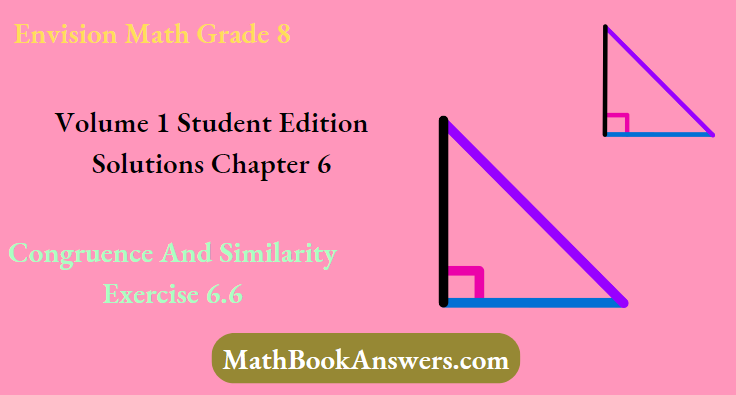
Page 334 Essential Question Answer
A dilation is a type of transformation that enlarges or reduces the size of a figure called the preimage.
A dilation is a type of transformation that create a new figure called the image, that has the same shape as the preimage but a different size than the preimage.
After dilation, the image has the same shape as the preimage, but the size of the image is a scaled version of the preimage.
Congruence And Similarity Envision Math Exercise 6.6 Answers
Page 335 Try It Answer
Given: A dilation marks the point L(3,6) to its image point L′(2,4). The preimage is given in the figure below:
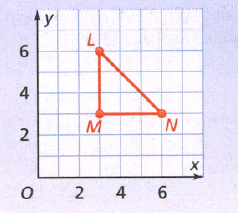
To find: The dilation image L’M’N’, the scale factor and length of the side M′N′.
Since L (3,6) → L′ (2,4) it follow that the scale factor k is
K = \(\frac{4}{6}=\frac{2}{3}\)

The other two vertices of ΔLMN are M(3,3),N(6,3)
The image of the vertex M after the dilation with a scale factor K = \(\frac{2}{3}\) is
\(M(3,3) \rightarrow M^{\prime}\left(\frac{2}{3} \cdot 3, \frac{2}{3} \cdot 3\right) \rightarrow M^{\prime}(2,2)\)The image of the vertex N after the dilation with a scale factor K = \(\frac{2}{3}\) is
\(N(6,3) \rightarrow N^{\prime}\left(\frac{2}{3} \cdot 6, \frac{2}{3} \cdot 3\right) \rightarrow N^{\prime}(4,2)\)With these points, the dilation figure L′M′N′ can be constructed as follows:
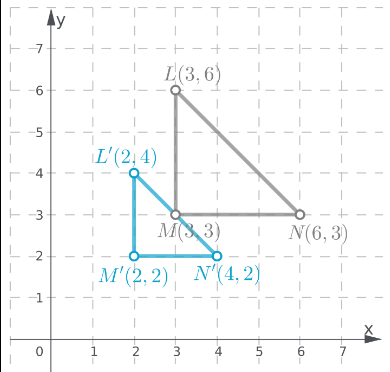
Hence, the image of ΔLMN, the ΔL′M′N′ is shown above.
Now, to find the length of side M ′N′, Let x1 be the x-coordinate of point M′(2,2) and x2 be the x-coordinate of point N′(4,2)
Since the side M′N′ is parallel to x−axis, length of the side M′N′ equals
x2 − x1 = ∣4∣ − ∣2∣
x2 − x1 = ∣2∣
The dilation with a scale factor K = \(\frac{2}{3}\) is shown below and the length of the side M′N′ is 2 units.
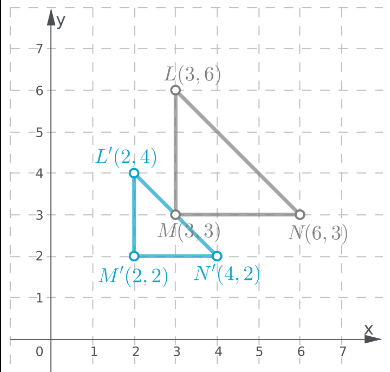
Envision Math Grade 8 Chapter 6.6 Explained
Envision Math Grade 8 Volume 1 Student Edition Solutions Chapter 6 Congruence And Similarity Exercise 6.6 Page 336 Exercise 2 Answer
If the scale factor k is between 0and 1, a dilation is a reduction.
If the scale factor k is between is greater than 1,a dilation is an enlargement.
Hence Proved.
Envision Math Grade 8 Volume 1 Student Edition Solutions Chapter 6 Congruence And Similarity Exercise 6.6 Page 336 Exercise 4 Answer
Given:
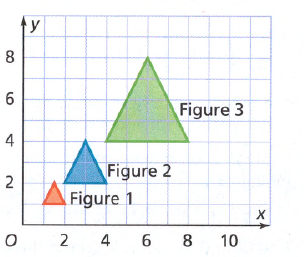
To find the scale factor of figure 3 with respect to figure 1.
We will calculate the base length of given figures.
The base length of the triangle in figure 1 is 1 unit.
The base length of the triangle in figure 3 is 4 unit.
Hence, the scale factor will be \(\frac{4}{1}\)
Evaluating the expression, it gives 4.
Hence, the scale factor is 4, which was derived by comparing the base lengths of the preimage and the image.
v
Envision Math Grade 8 Volume 1 Student Edition Solutions Chapter 6 Congruence And Similarity Exercise 6.6 Page 336 Exercise 5 Answer
To find: the coordinates of the image of Figure 2 after a dilation with center at the origin and a scale factor of 3.
We will find the vertices after the dilation by multiplying the scale factor with given vertices in figure 2.
Given:
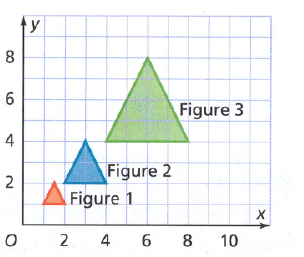
Figure 2:
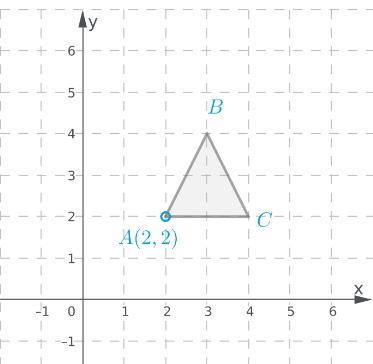
Let A,B,C be the vertices of the triangle in Figure 2. Point A is 2 units right and 2 units above the origin so its coordinates are (2,2).
Therefore, the vertices of the original image in Figure 2 are A(2,2),B(3,4),C(4,2).
To obtain the vertices of the image of triangle ΔABC after a dilation with a scale factor of 3,multiply the coordinates of points A, B and C by 3.
The image of point A after a dilation with a scale factor k = 3 is
A(2,2) → A′(3⋅2,3⋅2) → A′(6,6)
The image of point B after a dilation with a scale factor k = 3 is
B(3,4) → B′(3⋅3,3⋅4) → B′(9,12)
The image of point C after a dilation with a scale factor k = 3 is
C(4,2) → C′(3⋅4,3⋅2) → C′(12,6)
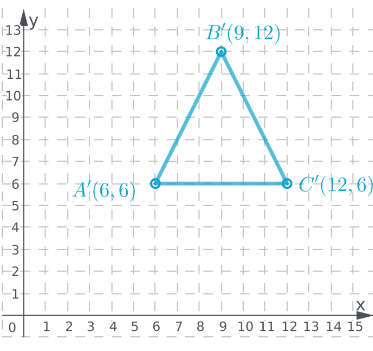
Therefore, the vertices of the image after dilation are A′(6,6), B′(9,12), C′(12,6)
Therefore, the vertices of the image after dilation are A′(6,6), B′(9,12), C′(12,6)
Page 337 Exercise 7 Answer
Given:
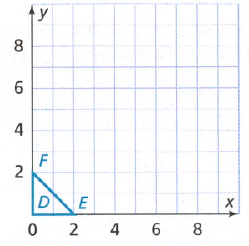
To find:
The coordinates of each point in the original figure.
D(−),(−)E(−),(−)F(−),(−)
Multiply each coordinate by _______
Find the coordinates of each point in the image:
D(−),(−)E(−),(−)F(−),(−)
Graph the image.
In order to obtain the vertices of the image of triangle after a dilation with a scale factor, we need to multiply the coordinates with that factor.
In the given graph;
Point D coincides with the origin, so the coordinates areD(0,0)
Point E is 2 units to the right of the origin, so the coordinates are E(2,0)
Point F is 2 units up from the origin, so the coordinates are F(0,2)
Therefore, the vertices of the initial triangle are;
D(0,0),E(2,0) and F(0,2))
To obtain the vertices of the image of the triangle ΔDEF after a dilation with a scale factor of 2, multiply the coordinates by 2.
The image of the point D after a dilation with the scale factor k = 2 is:
D(0,0) → D′(2⋅0,2⋅0) → D′(0,0)
The image of the point E after a dilation with the scale factor k = 2 is:
E(2,0) → E′(2⋅2,2⋅0) → E′(4,0)
The image of the point F after a dilation with the scale factor k = 2 is:
F(0,2) → F′(2⋅0,2⋅2) → F′(0,4)
Therefore, the vertices of the final triangle are D(0,0),E(4,0) and F(0,4).
Plot the points D′(0,0),E′(4,0) and F′(0,4):

The triangle D′E′F′ is shown:
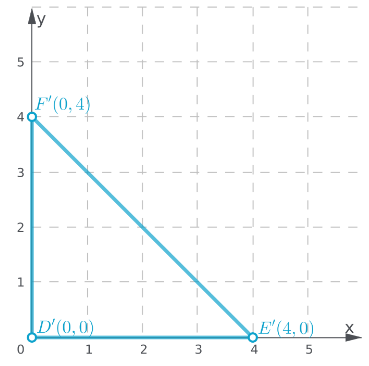
The triangle D′E′F′ is shown.
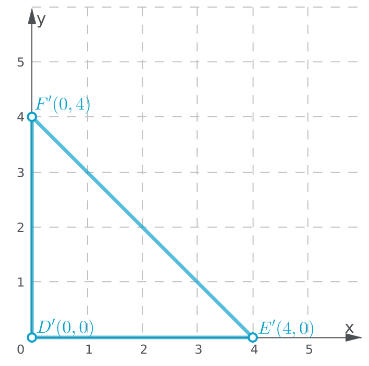
The vertices of the initial triangle are D(0,0),E(2,0) and F(0,2)
Multiply the coordinates by 2 to obtain the vertices of the final triangle:
D(0,0),E(4,0) and F(0,4)
Envision Math Grade 8 Volume 1 Chapter 6.6 Practice Problems
Envision Math Grade 8 Volume 1 Student Edition Solutions Chapter 6 Congruence And Similarity Exercise 6.6 Page 337 Exercise 8 Answer
Given:

To find:
The scale factor for the dilation
In order to find the scale factor, we need to compare the ratios of both dilations and then divide the number in fraction to obtain the scale factor.
The rectangle FGDE has sides with length of 5 and 6 units.
The rectangle F′G′D′E′ has sides with length of 15 and 18 units.
Therefore, the ratio of the side length in F′G′D′E′ to a corresponding side in FGDE s:
\(\frac{15}{5}=\frac{18}{6}\)= \(\frac{3}{1}\)
Divide the numbers to get the scale factor: 3
The ratio of the side lengths is \(\frac{3}{1}\)
Therefore, the scale factor is 3
Envision Math 8th Grade Congruence And Similarity Topic 6.6 Key Concepts
Envision Math Grade 8 Volume 1 Student Edition Solutions Chapter 6 Congruence And Similarity Exercise 6.6 Page 337 Exercise 10 Answer
Given:
In the figure small figure is dilation of large figure, origin is the center of dilation.
To find:
Whether the dilation is an enlargement or a reduction, and find the scale factor of the dilation.
In order to find the dilation is enlarge or reduce and to find the scale factor we have to refer to the tip mentioned.
The rectangle EFGH has the side length of 12 units.
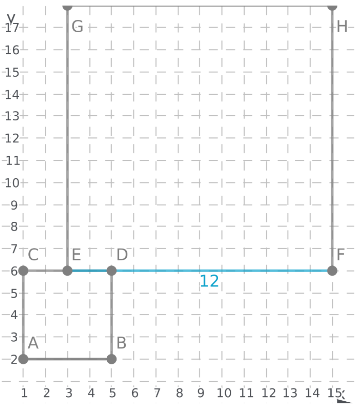
The rectangle ABCD has a side length of 4 units.

Now the smaller figure, rectangle ABCD is the dilation of the larger rectangle EFGH. The larger figure is diluting in a smaller figure.
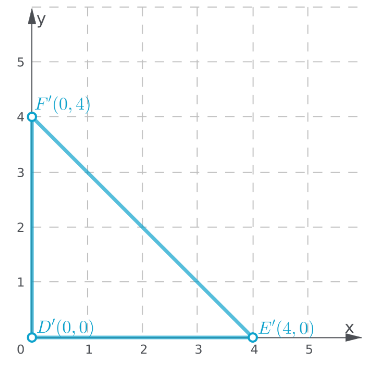
The Reduction is when a larger figure dilates into the smaller figure. Therefore, the dilation is a reduction.
The Scale factor is the ratio between the two same figures but different in sizes.
Scale Factor = Side length of \(\frac{A B C D}{E F G H}\)
Here, Side length of ABCD = 4 and EFGH = 12
Scale factor = \(\frac{4}{12}\)
Dividing the terms with 4.
Scale factor = \(\frac{1}{3}\)
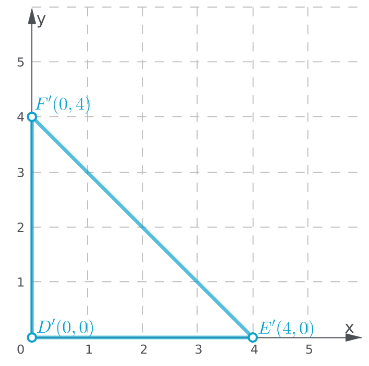
The dilation is a reduction with the scale factor = \(\frac{1}{3}\)
Envision Math Grade 8 Chapter 6.6 Lesson Overview
Envision Math Grade 8 Volume 1 Student Edition Solutions Chapter 6 Congruence And Similarity Exercise 6.6Page 338 Exercise 13 Answer
Given:
Rectangle Q′U′A′D′ with its coordinates and Q′,U′,A′,D′, is the image of QUAD after a dilation with center, and scale factor is 6.
To find:
Coordinates of point D′.
In order to find the coordinates of D′ we have to first find the coordinates of D and then multiply it with the scale factor.
Plot the points Q(0,0),U(0,3),A(6,3) and D(6,0) to form the quadrilateral.
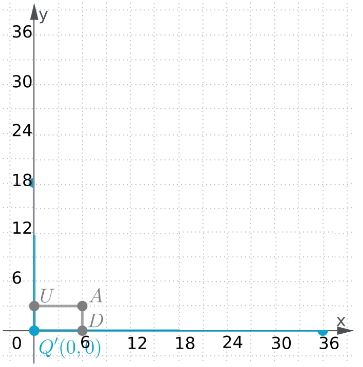
Since the center of dilation is (0,0), the coordinates of the points can be multiplied by the scale factor.
since, the scale factor is 6, it multiply all coordinates of all points by it:
Q(6⋅0,6⋅0) → Q′(0,0)
U(6⋅0,6⋅3) → U′(0,18)
A(6⋅6,6⋅3) → A′(36,18)
D(6⋅6,6⋅0) → D′(36,0)
Therefore the coordinates of the point D′ are (36,0)
Plot the points Q′(0,0), U′(0,18), A′(36,18), D′(36,0) to plot the dilated quadrilateral.
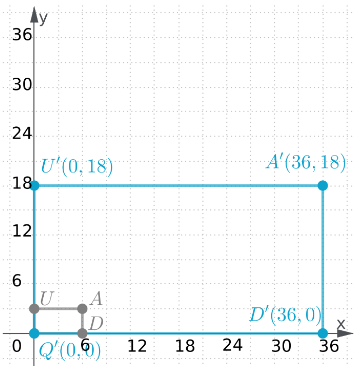
The coordinates of the point D′ are (36,0). The dilated quadrilateral Q′U′A′D′ is shown.

